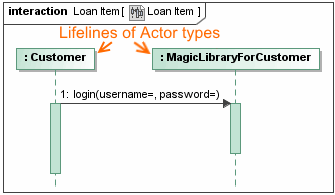Actors represent roles played by human users, external hardware, and other subjects. An Actor does not necessarily represent a specific physical entity but merely a particular “role” of some entities that is relevant to an action performed by the Actor. Typically, such actions are called Use Cases. An Actor is represented as a “stick man” figure with the name below the figure.
You can format the actor symbol properties in the Symbol Properties dialog.
An Actor can be specified by changing its property values in the Actor Specification window. Each property is described in the description area on this window.
Actors can be represented in other diagrams, such as Sequence or Activity diagrams.
Actor usage in other diagrams
The actor can be used in other diagrams in various ways. Most common cases are as follows:
- Actors can be depicted as Lifelines in a Sequence diagram.
- Actors can be depicted as Swimlane headers in an Activity diagram.
To create a Lifeline for an Actor in a Sequence diagram
- Open the Sequence diagram wherein you want to create a lifeline.
- Select an Actor in the Model Browser.
Drag and drop the selected Actor on the Sequence diagram pane. The Lifeline is created. In the following figure, see an example wherein two Lifelines are depicted.
To create a Swimlanes header for an Actor in an Activity diagram
- Open an Activity diagram.
- Create a Swimlane.
- Select an Actor in the Model Browser.
- Drag and drop the Actor on the Swimlane header in the Activity diagram. The Actor is assigned to the header of the Swimlane. See the example in the following figure.
You can see the usage of Actors in the example of Use Case diagram in <MagicDraw installation directory>\samples\diagrams\use case diagram.mdzip.


